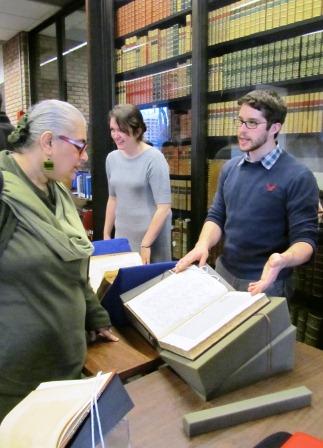
Jonas Clark loved books. In fact, the founder of Clark University was so passionate about volumes filled with words in languages both modern and ancient, and illustrations etched with detail and delicacy, that he accrued a personal library estimated at 10,000 books. In 1889, he donated some 4,000 volumes to the University’s library, and today an incredible historical and literary array is housed in Special Collections at the Goddard Library.
Many of Jonas Clark’s books were on display Dec. 6 for the Rare Book Open House, conducted by students from English Professor Meredith Neuman’s Introduction to Archival Research seminar. Students shared examples of medieval and Renaissance books and explained topics from early paper making and typography to bindings and illustrations, to hand-press printing processes and manuscript reader annotations. Visitors were treated to hands-on stations for exploration as well as several online projects for viewing.
Clark archivist Fordyce Williams noted that among Clark’s books are 40 “incunabula” — books, pamphlets, or broadsides published in Europe after the invention of the Gutenberg press in 1455 and before the year 1501.
Among the works on display in the Clark collection is a “Book of Hours,” a devotional book composed in Latin in 1420 and bound in vellum. Another volume on display, “Nuremburg Chronicles” (1493), is the product of Anton Koberger, known at the time as “The Prince of Printing.” (The oldest of Clark’s volumes, Williams said, is a handwritten, hand-painted manuscript from 1275.) Also displayed was the “Expositionis Evangeliorum dominicalium” (1480), a book of sermons published by Albertus de Padua. Senior Eric Devenney pointed to a small, thin, semi-translucent circle in one of the book’s pages, a phenomenon known as a “vat man’s tear” — an imperfection made by a drop of sweat from a worker making the hand laid paper.
Shalyn Hopley ’14 presented examples of “colophons” — brief descriptions at the end of books that described the printing process. “It was a statement about the printer’s pride in the book, and how difficult the task was,” Hopley said.
Neuman’s own research often focuses on print and manuscript archival sources, ranging from notebooks kept by Puritans when they were listening to sermons, to amateur manuscript poetry, to readers’ marks in print books, to the history and context of the Mather family’s vast personal library. She noted that Jonas Clark had an affection for travel writing, maps and illustrations, and bindings. A tangible outcome of the Clark project, Neuman said, is that students have begun creating descriptions and databases of the Clark collection, enabling access for researchers all over the world.


